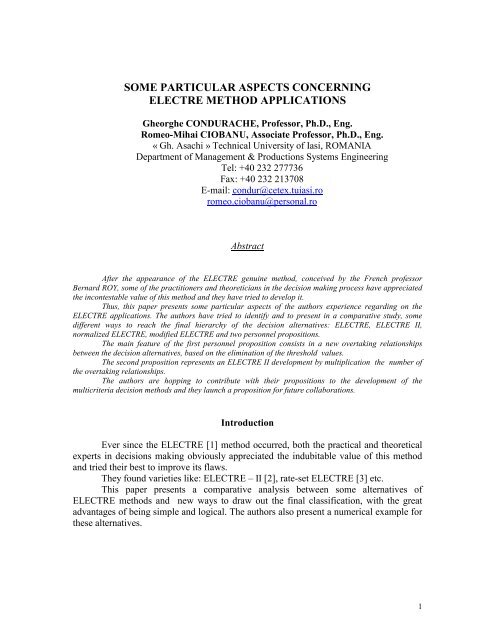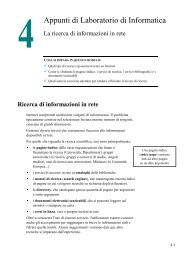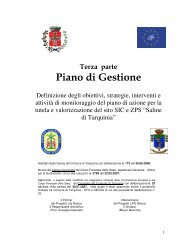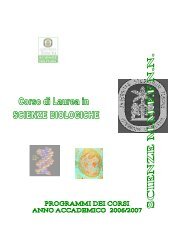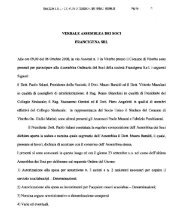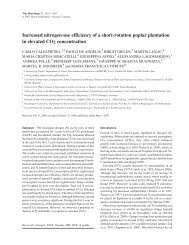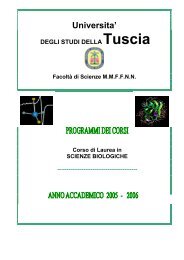some particular aspects concerning electre method applications
some particular aspects concerning electre method applications
some particular aspects concerning electre method applications
You also want an ePaper? Increase the reach of your titles
YUMPU automatically turns print PDFs into web optimized ePapers that Google loves.
SOME PARTICULAR ASPECTS CONCERNING<br />
ELECTRE METHOD APPLICATIONS<br />
Gheorghe CONDURACHE, Professor, Ph.D., Eng.<br />
Romeo-Mihai CIOBANU, Associate Professor, Ph.D., Eng.<br />
« Gh. Asachi » Technical University of Iasi, ROMANIA<br />
Department of Management & Productions Systems Engineering<br />
Tel: +40 232 277736<br />
Fax: +40 232 213708<br />
E-mail: condur@cetex.tuiasi.ro<br />
romeo.ciobanu@personal.ro<br />
Abstract<br />
After the appearance of the ELECTRE genuine <strong>method</strong>, conceived by the French professor<br />
Bernard ROY, <strong>some</strong> of the practitioners and theoreticians in the decision making process have appreciated<br />
the incontestable value of this <strong>method</strong> and they have tried to develop it.<br />
Thus, this paper presents <strong>some</strong> <strong>particular</strong> <strong>aspects</strong> of the authors experience regarding on the<br />
ELECTRE <strong>applications</strong>. The authors have tried to identify and to present in a comparative study, <strong>some</strong><br />
different ways to reach the final hierarchy of the decision alternatives: ELECTRE, ELECTRE II,<br />
normalized ELECTRE, modified ELECTRE and two personnel propositions.<br />
The main feature of the first personnel proposition consists in a new overtaking relationships<br />
between the decision alternatives, based on the elimination of the threshold values.<br />
The second proposition represents an ELECTRE II development by multiplication the number of<br />
the overtaking relationships.<br />
The authors are hopping to contribute with their propositions to the development of the<br />
multicriteria decision <strong>method</strong>s and they launch a proposition for future collaborations.<br />
Introduction<br />
Ever since the ELECTRE [1] <strong>method</strong> occurred, both the practical and theoretical<br />
experts in decisions making obviously appreciated the indubitable value of this <strong>method</strong><br />
and tried their best to improve its flaws.<br />
They found varieties like: ELECTRE – II [2], rate-set ELECTRE [3] etc.<br />
This paper presents a comparative analysis between <strong>some</strong> alternatives of<br />
ELECTRE <strong>method</strong>s and new ways to draw out the final classification, with the great<br />
advantages of being simple and logical. The authors also present a numerical example for<br />
these alternatives.<br />
1
1.The first original proposition (ELECTRE IV)<br />
In [4] the authors have proposed the next hierarchical relationship:<br />
If: c hg . ≥ c hg<br />
d gh ≤ d hg<br />
↔ A g is better than A h . ( A g P A h )<br />
where :<br />
c gh - the concordance indicator between the A g and A h alternatives;<br />
d gh - the discordance indicator between the A g and A h alternatives;<br />
This <strong>method</strong> has an inconvenience: even if both the alternatives (A g and A h ) have<br />
a major flaw, one of them will be accepted anyway, which is contrary to the principle of<br />
the original <strong>method</strong>, that doesn’t agree with accepting an alternative with a major flaw.<br />
Comparing our solution with the ELECTRE II <strong>method</strong> solution we can see that<br />
the hierarchical relationship we proposed:<br />
c gh ≥ c hg<br />
is identical with the ELECTRE II relationship:<br />
P + gh/ P - gh ≥ 1<br />
where:<br />
P + gh – is the amount of better criteria in favor of the A g alternative as comparing with the<br />
A h<br />
alternative.<br />
P - gh – is the amount of better criteria in favor of the A h alternative as comparing with the<br />
A g alternative.<br />
Our suggestion, which we can name the ELECTRE IV, is based on the following:<br />
the second relationship:<br />
d gh ≤ d hg<br />
can be completed by a third relationship, like d gh ≤ d, thus getting rid of the<br />
inconvenience; d is a discordance threshold, whose value is imposed by the decision<br />
maker (over 0,5 in our opinion).<br />
2. The second original proposition<br />
ELECTRE II <strong>method</strong> has proposed a concept of tough and mild hierarchy, which<br />
we can generalize, using the “hierarchical rank” – meaning the order in which we’ve<br />
done the hierarchy. How could we show this using a calculus?<br />
A suggestion might be the following: (ELECTRE V). In the hierarchical graph we<br />
can add an arrow every time the concordance or discordance threshold respectively<br />
changes. This may lead to the selection of the alternative for which we obtain a “better<br />
hierarchical difference” as comparing to the alternatives for which we get “mild<br />
hierarchical differences”.<br />
2
Issue Method Overtaking<br />
relationships<br />
1. ELECTRE I If : c gh ≥ c; d gh ≤ d<br />
↔ A g P A h<br />
2. ELECTRE II If : c gh ≥ c; d gh ≤ d<br />
↔ A g P A h<br />
P + gh /P - gh ≥ 1;<br />
3. ELECTRE<br />
III<br />
4. ELECTRE<br />
IV (original<br />
alternative)<br />
5. ELECTRE V<br />
(original<br />
alternative)<br />
6. Modified<br />
ELECTRE<br />
7. Rate –set<br />
ELECTRE<br />
If : c gh ≥ c; d gh ≤ d<br />
↔ A g P A h<br />
P gh + /P gh - ≥ 1;<br />
If c gh ≥ c hg ; d gh ≤<br />
d hg ; d ≤ 1<br />
↔ A g P A h<br />
If : c gh ≥ c; d gh ≤ d<br />
↔ A g P A h<br />
If: c gh – d gh ≥ c – d<br />
↔ A g P A h<br />
The<br />
discordance<br />
indicator:<br />
d gh = ∑ j (u hj – u gj ) · k j<br />
where :<br />
k j – the importance<br />
level of C J criteria<br />
Table no.1. ELECTRE Methods<br />
Decision algorithm<br />
Aforementioned algorithm<br />
It uses two pairs of threshold values: one pair for<br />
tough overtaking and one pair for mild<br />
overtaking. We consider the both directly an<br />
indirectly hierarchies. The tough classification is<br />
completed by the mild classification..<br />
It proposes the concept named insensbility for<br />
the discordance indicators less then threshold<br />
value. It makes directly and indirectly<br />
classification for the alternatives.<br />
The threshold values disappear, the comparing it<br />
makes between the values from matrix. The result<br />
is getting by the ELECTRE II <strong>method</strong>.<br />
Each overtaking relationship is marked every time<br />
when are modified the threshold values. Hereby,<br />
the alternative which have bigger values of<br />
concordance indicators or/and less values of<br />
discordance indicators will obtain more<br />
overtaking relationships than all of others.<br />
It subtractions the discordances matrix from the<br />
concordances matrix and the line which have<br />
more positives values indicates the optimal<br />
alternative.<br />
This way, an alternative with lots of small<br />
disadvantages can be defeated by another one<br />
with only one big disadvantage.<br />
We illustrate our suggested solutions with the following numericalal example. In<br />
the following application there are presented <strong>some</strong> of the <strong>method</strong>s.<br />
3
3. Example of ELECTRE <strong>method</strong>s application<br />
We propose to settle the optimum strategy for a firm, wich has more investment<br />
projects, and its efficiency indicators for macroeconomics conditions (the consequences<br />
matrix), more probable (considerates safes ) are presented in the table no. 2.<br />
Decision C 1<br />
criteria Net Present<br />
C j Value<br />
Alternative [mil. lei]<br />
A I<br />
C 2<br />
Payback<br />
period of<br />
investment<br />
[year]<br />
Table no.2. Consequences Matrix<br />
C 3<br />
C 4<br />
Minimal Life Internal Rate<br />
Cycle of Return<br />
[year] [ % ]<br />
A 1 5.500 ∗ 5,0 ο 3,7 40<br />
A 2 5.000 4,7 4,2 ο 50 ∗<br />
A 3 4.800 4,5 3,6 38<br />
A 4 4.300 4,3 3,0 ∗ 30 ο<br />
A 5 4.000 ο 4,0 ∗ 3,6 40<br />
K j 0,4 0,3 0,2 0,1<br />
Note: it has been marked with * the best solution for the respective criteria and with °<br />
the poor solution for the respective criteria.<br />
We constate that doesn’t exist a solution which can be the best in evidently and a<br />
solution which can be the powerless than all others.<br />
In table no.3. there are calculated the utilities, if the references values X j , Y j<br />
are those from the table no.2, marked with *, respective with °.<br />
C j<br />
Table no.3. Utilities Matrix<br />
A I<br />
C 1 C 2 C 3 C 4 U i Classif.<br />
A 1 1,00 0,00 0,41 0,50 1,91 IV<br />
A 2 0,67 0,30 0,00 1,00 1,97 II<br />
A 3 0,53 0,50 0,50 0,40 1,93 III<br />
A 4 0,20 0,70 1,00 0,00 1,90 V<br />
A 5 0,00 1,00 0,50 0,50 2,00 I<br />
K j 0,4 0,3 0,2 0,1<br />
The concordance and discordance indicators are shown in the table no.4 şi 5.<br />
Table no.4. Concordance Matrix (c gh )<br />
c gh A 1 A 2 A 3 A 4 A 5<br />
A i X 0,6 0,5 0,5 0,5<br />
A 2 0,4 X 0,5 0,5 0,5<br />
A 3 0,5 0,5 X 0,5 0,5<br />
A 4 0,5 0,5 0,5 X 0,6<br />
A 5 0,6 0,5 0,6 0,4 X<br />
4
Table no. 5. Discordance Matrix (d gh )<br />
d gh A i A 2 A 3 A 4 A 5<br />
A i X 0,5 0,5 0,7 1,0<br />
A 2 0,41 X 0,5 1,0 0,7<br />
A 3 0,47 0,6 X 0,5 0,5<br />
A 4 0,8 1,0 0,4 X 0,5<br />
A 5 1,0 0,67 0,53 0,5 X<br />
ELECTRE I: The minimum threshold value of the concordance indicator which<br />
can be totally overtake by an alternative is c = 0,5. The maximal value of the discordance<br />
threshold which can be totally overtake by an alternative is d = 0,6. In table no.6 there<br />
are presented the overtaking relationaships between the alternatives, for this two<br />
threshold values.<br />
Table no.6. ELECTRE I<br />
A (0,5; 0,6) A 1 A 2 A 3 A 4 A 5 Classif.<br />
A 1 X Yes Yes No No II<br />
A 2 No X Yes No No III<br />
A 3 Yes Yes X Yes Yes I<br />
A 4 No No Yes X Yes II<br />
A 5 No No Yes No X III<br />
The classification it made by the summation of the overtaking relationships. The<br />
alternative A 3 is preferates, because this, without have the performances, it is equilibrate,<br />
it not has the majore handicaps and it’s preferates by 1/2 from criterias.<br />
ELECTRE II: The Matrix of concordance indicatores is decomposed in: the<br />
overtaking nett matrix ( P gh + ) and the equivalence matrix (P gh = ), as: u gj > u hj , respective:<br />
u gj =u hj . These two matrix are presented in the tables no.7 and 8.<br />
Table no.7. Overtaking nett matrix (P + gh)<br />
+<br />
P gh A 1 A 2 A 3 A 4 A 5<br />
A 1 X 0,6 0,5 0,5 0,4<br />
A 2 0,4 X 0,5 0,5 0,5<br />
A 3 0,5 0,5 X 0,5 0,3<br />
A 4 0,5 0,5 0,5 X 0,6<br />
A 5 0,5 0,5 0,4 0,4 X<br />
5
P gh<br />
=<br />
Table no.8. Equivalence matrix (P gh = )<br />
A 1 A 2 A 3 A 4 A 5<br />
A 1 X 0 0 0 0,1<br />
A 2 0 X 0 0 0<br />
A 3 0 0 X 0 0,2<br />
A 4 0 0 0 X 0<br />
A 5 0,1 0 0,2 0 X<br />
For example, the classification for the threshold values: c= 0,5; d = 0,5 is<br />
presented in the table no.9.<br />
Table no.9. ELECTRE II<br />
A(0,5; 0,5) A 1 A 2 A 3 A 4 A 5 Classif.<br />
A 1 X Yes Yes No No I<br />
A 2 No X Yes No No II<br />
A 3 Yes No X Yes No I<br />
A 4 No No Yes X Yes I<br />
A 5 No No No No X III<br />
The mild classification can be achieved for the pair c=0,5; d=0,6. This contains,<br />
more, overtaking relationships: A 3 P A 1 ; A 5 P A 3 .<br />
The tough overtaking drive us to un inserting result, because three alternatives are<br />
equally.<br />
The second classification decides for alternative A 3 , which realizes the overtaking<br />
of A 1 .<br />
ELECTRE IV: It compares the indicators’ value c gh and c hg , respective d gh and<br />
d hg , alternative which are satisfying the both comparing, being better than other. Thus, we<br />
can constat :<br />
c 12 >c 21 ; d 12 >d 21 , as a consequence we can’t satisfy the both relations for each<br />
relations between the alternatives;<br />
c 13 =c 31 ; d 13 >d 31 , alternative A 3 are satisfying at limits the conditions, so it<br />
overtakes the A 1 alternative;<br />
c 15 < c 51 ; d 15 =d 51 = 1,0 in this case not even one of the alternatives can be declared<br />
eligible. The overtaking matrix is show in the table no.10.<br />
Table no.10. ELECTRE IV<br />
ELECTRE IV A 1 A 2 A 3 A 4 A 5 Classif.<br />
A 1 X No No Yes No II<br />
A 2 No X Yes No No II<br />
A 3 Yes No X No No II<br />
A 4 No No Yes X Yes I<br />
A 5 No Yes No No X II<br />
6
So, the optimal alternative is A 4 , being the only one which are overtaking two<br />
alternatives. The others have each one overtaking.<br />
Modified ELECTRE: It subtractions the discordance indicators matrix from<br />
the concordance indicators matrix: c gh – d gh .The resulted are presented in the table<br />
no.11.<br />
Table no.11. Modified ELECTRE<br />
c gh – d gh A 1 A 2 A 3 A 4 A 5 Class<br />
A 1 X 0,1 0 -0,2 -0,5 III<br />
A 2 -0,01 X 0 -0,5 -0,2 IV<br />
A 3 0,03 -0,1 X 0 0 I<br />
A 4 -0,3 -0,5 0,1 X 0,1 V<br />
A 5 -0,4 -0,17 0,07 -0,1 X II<br />
The alternative A 3 stands out in top . The other three alternatives have the values<br />
very close.<br />
Ascertainment: Generally speaking, the decisions making <strong>method</strong>s don’t offer<br />
the same results (only in a less measure). In the table no.12 are centralized the<br />
classements obtained by applying the previous <strong>method</strong>s.<br />
Method<br />
A i<br />
ELECTRE<br />
I<br />
ELECTRE<br />
II<br />
Table nr.12. The alternatives classification<br />
ELECTRE<br />
IV<br />
Modified<br />
ELECTRE<br />
Total<br />
Final<br />
classification<br />
A 1 2 1 2 3 8 II<br />
A 2 3 2 2 4 11 V<br />
A 3 1 1 2 1 5 I<br />
A 4 2 1 1 5 9 III<br />
A 5 3 3 2 2 10 IV<br />
In the last columns of the table we made a sum of the partial classification,<br />
respective last order, applying the rule of the simple sum <strong>method</strong> of the ranges. The idea<br />
is the alternative which is more close to the first place is the best alternative. But this<br />
conclusion is not compulsory. As there is a <strong>method</strong> of dictator, in which the decision<br />
maker can choose a single criteria from many others, same it is possible to choose by a<br />
single criteria or a single decision <strong>method</strong> group and is not necessarily to choose all the<br />
<strong>method</strong>s<br />
7
Conclusion<br />
In this paper, the authors have presented <strong>some</strong> <strong>particular</strong> <strong>aspects</strong> of their<br />
experience regarding on the ELECTRE <strong>method</strong> application. They have tried to identify<br />
and to present in a comparative study, <strong>some</strong> different ways to reach the final hierarchy of<br />
the decision alternatives: ELECTRE, ELECTRE II, modified ELECTRE and two<br />
personnel propositions.<br />
The main feature of the first personnel proposition consists in a new overtaking<br />
relationships between the decision alternatives, based on the elimination of the threshold<br />
values.<br />
The second proposition represents an ELECTRE II development by multiplication<br />
the number of the overtaking relationships.<br />
The authors are hopping to contribute with their propositions to the development<br />
of the multicriteria decision <strong>method</strong>s and they launch a proposition for future<br />
collaborations.<br />
Bibliography<br />
[1] Roy, B. – Classement et choix en présence de points de vue multiples (la méthode<br />
ELECTRE), in RIRO (Revue Internationale de Recherche Opérationnelle), no. 8, marsavril,<br />
1968.<br />
[2] Godet, M. – De l’anticipation à l’action, Edition Dunod, Paris, 1991.<br />
[3] Teodorescu, N., ş.a. – Metode ale cercetării operaţionale în gestiunea<br />
întreprinderilor, Editura Tehnică, Bucureşti, 1972.<br />
[4] Ştirbu, C., Condurache, Gh. – Consideraţii privind aplicarea metodei ELECTRE. În<br />
Studii şi cercetări de calcul economic şi cibernetică economică, nr. 4/1974.<br />
[5] Condurache, Gh. – Din nou despre ELECTRE. În Conferinţa de management, vol.<br />
II, Iasi, Romania, 23-25 noiembrie 1995.<br />
8


